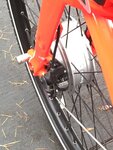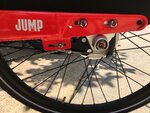D
Deleted member 4210
Guest
Even a Citibike employee claims 'cheap ebikes ' and 'quick fixes ' and said he 'knew ' this was gonna happen.
https://www.nydailynews.com/new-yor...0190421-5fq26lrlbvbihj2re7zpqhiepi-story.html
The primary reason for posting this, is not to slam Citibike or others like Lyft here in Chicago who yanked these ebikes after the accidents, but to let people know that the front brakes on these ebike share bikes, are very different than nearly any consumer sold ebike. They are using a rather odd front enclosed 'drum' brake, that Shimano is claiming that these firms improperly applied without using what they term a 'power modulator.' More than likely this power modulator, is similar to the function of ABS that we know about for cars. It would make sense that it would 'pulse' the brakes rapidly to prevent brake and wheel from locking up too suddenly. (And throwing the rider over the handle bars - not good).
On regular ebikes you either see disc brakes or caliper style brakes. Not these drum brakes.
The injured riders sound like they have a very serious claim, and the suddenness of the stopping using the brakes, seems really unusual.
It's too bad this happened and let's hope there is not too much negative fall out that scares would be ebike buyers from moving ahead.
https://www.nydailynews.com/new-yor...0190421-5fq26lrlbvbihj2re7zpqhiepi-story.html
The primary reason for posting this, is not to slam Citibike or others like Lyft here in Chicago who yanked these ebikes after the accidents, but to let people know that the front brakes on these ebike share bikes, are very different than nearly any consumer sold ebike. They are using a rather odd front enclosed 'drum' brake, that Shimano is claiming that these firms improperly applied without using what they term a 'power modulator.' More than likely this power modulator, is similar to the function of ABS that we know about for cars. It would make sense that it would 'pulse' the brakes rapidly to prevent brake and wheel from locking up too suddenly. (And throwing the rider over the handle bars - not good).
On regular ebikes you either see disc brakes or caliper style brakes. Not these drum brakes.
The injured riders sound like they have a very serious claim, and the suddenness of the stopping using the brakes, seems really unusual.
It's too bad this happened and let's hope there is not too much negative fall out that scares would be ebike buyers from moving ahead.
Last edited by a moderator:

